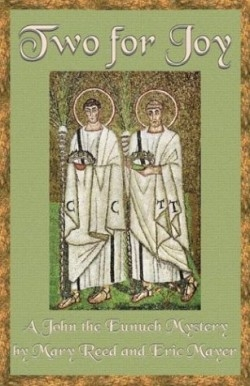Two for Joy
It is sixth century Constantinople. Justinian I is the ruler of the Roman Empire, which is under constant external threat from Persia. Inside the empire factions of charioteers, the Blues and the Greens, wage ganglike warfare on each other and anyone in their way; holy men known as stylites live atop pillars and preach to and incite crowds; senators and politicians plot to increase their power and influence while staying on the good side of Emperor Justinian and his wife, Theodora, who has an agenda often quite separate from that of her husband’s.
Then a religious zealot, Michael, predicts that God will strike down several of the stylites with a cleansing fire—and three of them are simultaneously struck by lightning. Was this an actual act of holy might…or something else entirely?
Lord John Chamberlain—the emperor’s chief advisor—is directed to investigate the divine deaths of the stylites. He is also sent on a diplomatic mission to discuss “terms” with Michael. John is a shrewd, skeptical man. Educated from an early age, his life was turned upside-down when he was kidnapped and sold into slavery. A scholar and a former mercenary, now having risen to the highest level in the emperor’s court, he understands all too well that one misstep can end in death. He is also a eunuch and a practicing Mythran, a pagan religion the emperor has outlawed. John doesn’t believe the stylites’ deaths were a divine act, but he does believe Michael might have known something about them. Finding out how—and why—will require the untangling of byzantine political treacheries, staying out of the way of Empress Theodora’s own dangerous plotting, and carefully avoiding the violence within the city’s walls that grows worse each day. Add on a senator’s poisoning, a prostitute’s apparent spontaneous combustion, and John has his hands full.
Two for Joy is textured and detailed. The characters are deftly drawn, complex and fascinating. The threads of plot are intricate and satisfying, woven as they are through authentic-seeming detail and atmosphere. The “science” behind the “holy fires” has been thoroughly documented by historians and archaeologists. It’s unfortunate that the authors didn’t clearly explain how this particular feat was actually accomplished. This fault, though, doesn’t prevent the novel from being an especially bright spot in this year’s output of mystery novels.
Reviewed by
Mark Terry
Disclosure: This article is not an endorsement, but a review. The publisher of this book provided free copies of the book to have their book reviewed by a professional reviewer. No fee was paid by the publisher for this review. Foreword Reviews only recommends books that we love. Foreword Magazine, Inc. is disclosing this in accordance with the Federal Trade Commission’s 16 CFR, Part 255.

